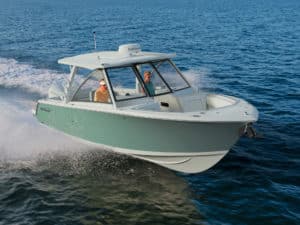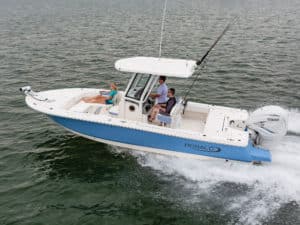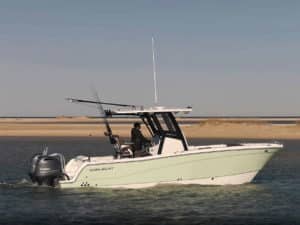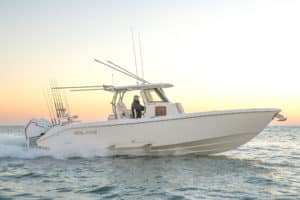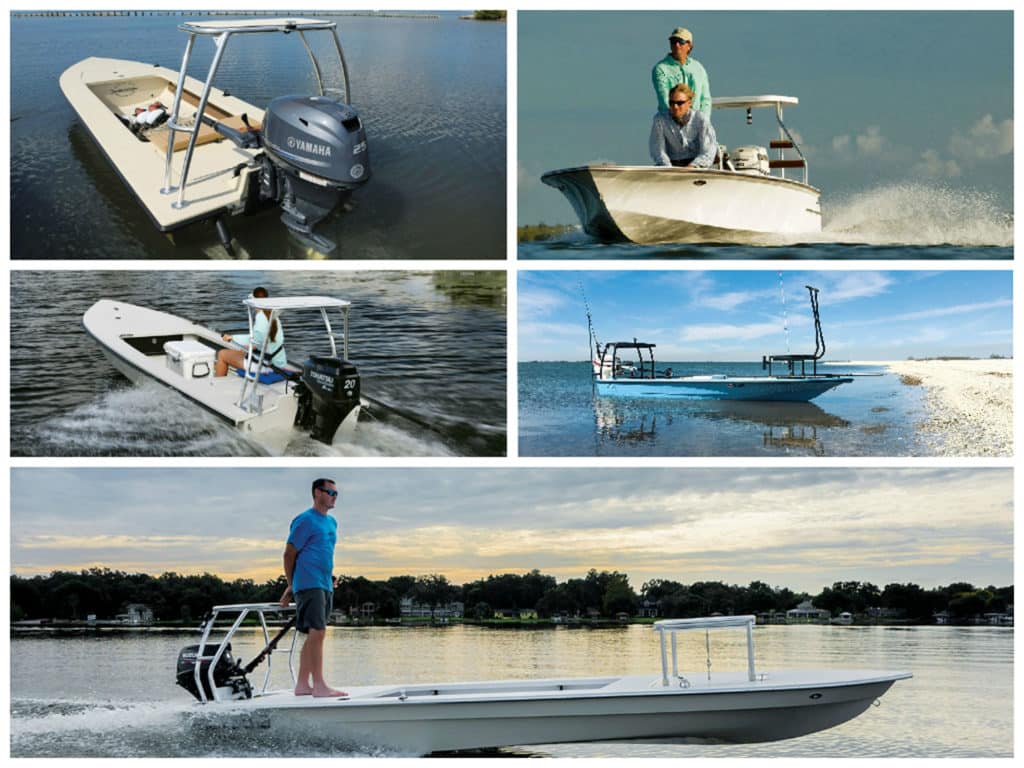
The line between small flats skiff and microskiff frequently blurs among anglers and even boatbuilders. This peculiar breed of petite boat often draws hardcore anglers addicted to stalking skinny-water fish. Often those anglers care nothing for trends or boat bragging, and frequently their budgets speak louder than their egos. A microskiff can also be a second boat for an angler whose allegiances waffle between blue water fishing and fishing grass flats.
To better set parameters defining microskiffs, I asked five builders to describe the design details that distinguish this vessel type, and to discuss its advantages and disadvantages. (Skiffs are listed by LOA from longest to shortest.)
– WATCH OUT FOR CARBON MONOXIDE –
Safety Tip Provided by the U.S. Coast Guard
Learn the signs and symptoms of carbon monoxide poisoning, such as headache, nausea, and dizziness. Immediately seek fresh air and medical assistance if anyone exhibits these symptoms.
Hell’s Bay Glades Skiff
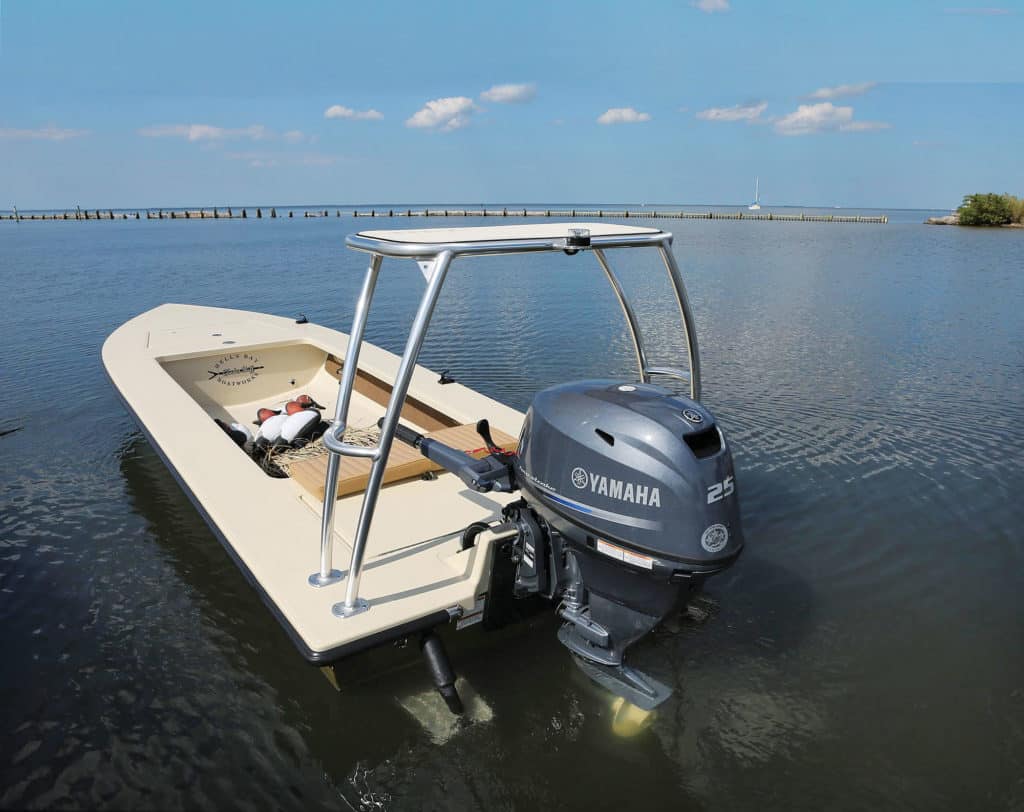
LOA: 17 ft. 8 in. • Beam: 4 ft. 10 in. • Transom Deadrise: 3 deg. • Draft: 4 in. • Dry Weight: 440 lb. • Max Power: 30 hp Courtesy Hell’s Bay
“When you think of a microskiff, you think of a skiff that has been pared down to the bare minimum,” says Todd Fuller, of Hell’s Bay. “A microskiff is unapologetically a tool designed to access water that can be reached by no other means.”
Microskiffs operate with a minimum amount of power. Often they employ an outboard that’s small enough to be removed for no-motor-zone access. That also means that they’re light enough to perform with lower horsepower, pole easily, and float in 4 to 5 inches of water fully loaded, Fuller says.
What are the pros and cons of microskiffs?
Pro: They can fish water usually accessible only to non-motorized canoes, paddleboards and kayaks, yet you don’t have to paddle.
Con: Because they’re minimalists, they generally fish just two anglers and offer few creature comforts. “You won’t find backrests, stereos or cupholders,” Fuller says.
Pro: They are super easy to pole on the flats and very quiet, and they operate very economically.
Con: The weight and flat bottom generally mean a rougher ride.
“The modern microskiff is a hybrid between the small flats skiff and working craft (like pirogues and pangas),” Fuller says. “It’s generally narrower than a regular skiff, with a flat or slightly arced bottom — no deadrise at the transom to speak of, in order to maximize displacement and minimize draft.
“The microskiff angler is a sportsman first. He wants as little between him and the fish as possible.”
– CHECK THE WEATHER –
Safety Tip Provided by the U.S. Coast Guard
The weather changes all the time. Always check the forecast and prepare for the worst case.
Ankona Shadowcast 18
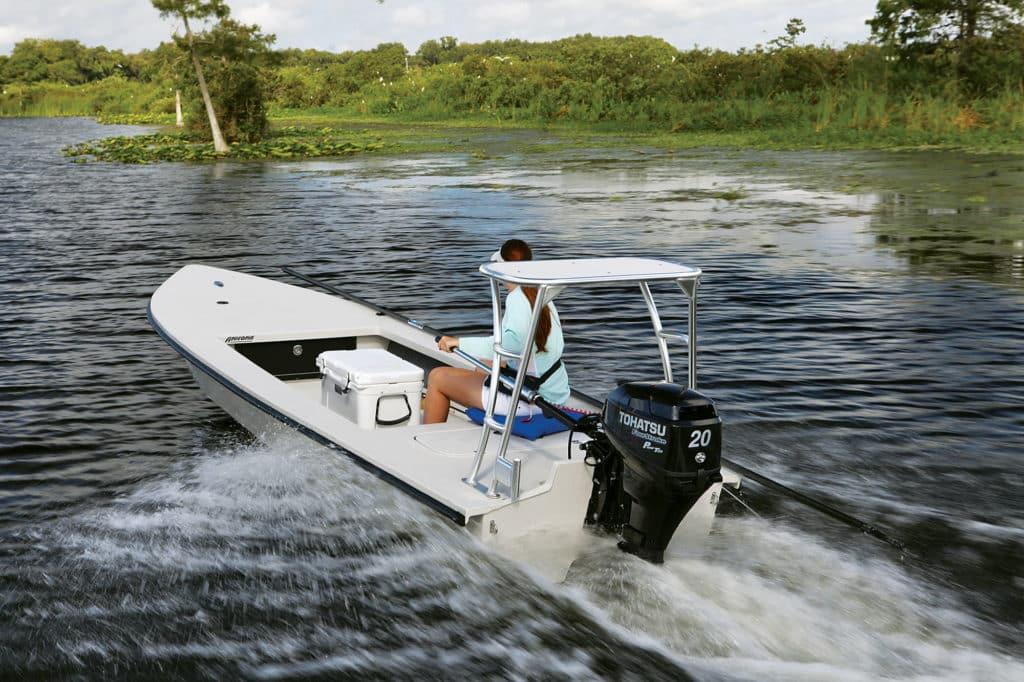
LOA: 17 ft. 8 in. • Beam: 4 ft. 10 in. • Transom Deadrise: 0 deg. • Draft: 5 in. • Dry Weight: 290 lb. • Max Power: 30 hp Courtesy Ankona
Typical microskiff parameters include poling in less than 6 inches of water, carrying a reasonable load of two anglers and gear, featuring a lower beam-to-length ratio than standard skiffs, and requiring less than 40 horsepower, says Erin Walker, of Ankona.
“The main advantage of the microskiff is they simply draw less than other shallow-water boats,” Walker says. “The best micros can pole in 4 to 5 inches. The blade on a kayak paddle is larger than that. And again, that’s taking a couple of anglers and gear.”
Given that draft factor, most micros sport very flat hull bottoms, at least once you get to the stern. “The best designs, though, have a pretty sharp V in the bow to give them a decent ride in chop,” she says. “Each manufacturer has its own idea on how far aft to run the deadrise and how to transition to the flat stern.”
The hull shape obviously affects the skiff’s ride, particularly across rough, open bays, but a captain’s experience and knowledge of boat handling can minimize discomfort.
“The microskiff attracts anglers who simply want to fish where others can’t,” Walker says. “A common thing I hear is ‘There aren’t any fish in 5 inches of water anyway.’ Well, they say that because they have no way to explore that water area. The anglers fishing microskiffs realize that having the ability to cross 4- to 6-inch flats can open up entirely new fishing territories also.”
East Cape Glide
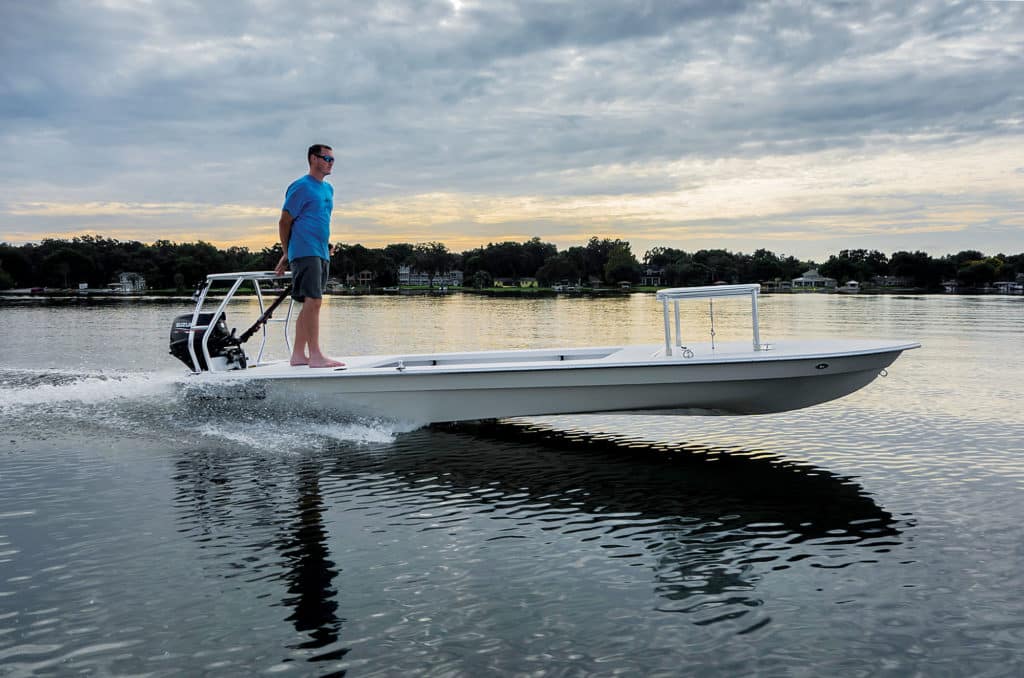
LOA: 17 ft. • Beam: 5 ft. 1 in. • Transom Deadrise: 4 deg. • Draft: 4-5 in. • Dry Weight: 370 lb. (tiller) or 415 lb. (side console) • Max Power: 30 hp Courtesy East Cape
“When is a boat a small flats skiff, and when is it a microskiff? This is a common question we get asked, and the answer is quite simple: Length and width with horsepower will decide if it’s a true microskiff,” says Kevin Fenn, of East Cape Skiffs. “So anything under 18 feet long, or less than 70 inches in beam, and powered with 30 hp or less is a ‘true’ microskiff.”
Fenn says he sees three kinds of microskiff anglers: those who prefer to keep things simple and might be moving up from a paddlecraft; those on a budget who want a well-made craft; and those who are sight-fishing purists, who want to stay away from the crowds and go “stupid shallow.”
True microskiffs with skinny beams can be tippier than other skiffs, Fenn notes. “If you want to pole easy and go skinny, it will come at a price — often that’s stability.”
The Glide features a 4-degree deadrise at the transom, but a sharp entry. Its chines sit well below the waterline, so the boat is super quiet, Fenn says. Another advantage: It launches anywhere.
“This is a niche that is slowly growing, and we’ve been in it for years,” Fenn says. “There’s no sign of slowing down.”
– TOW LIKE A PRO –
Safety Tip Provided by the U.S. Coast Guard
Remember to leave extra stopping room when trailering your boat. At the ramp, be considerate of others but take the time you need to launch and recover your boat safely. Always check tie-downs, safety chains, lights – and the drain plug.
Beaver Tail 16 BT Micro
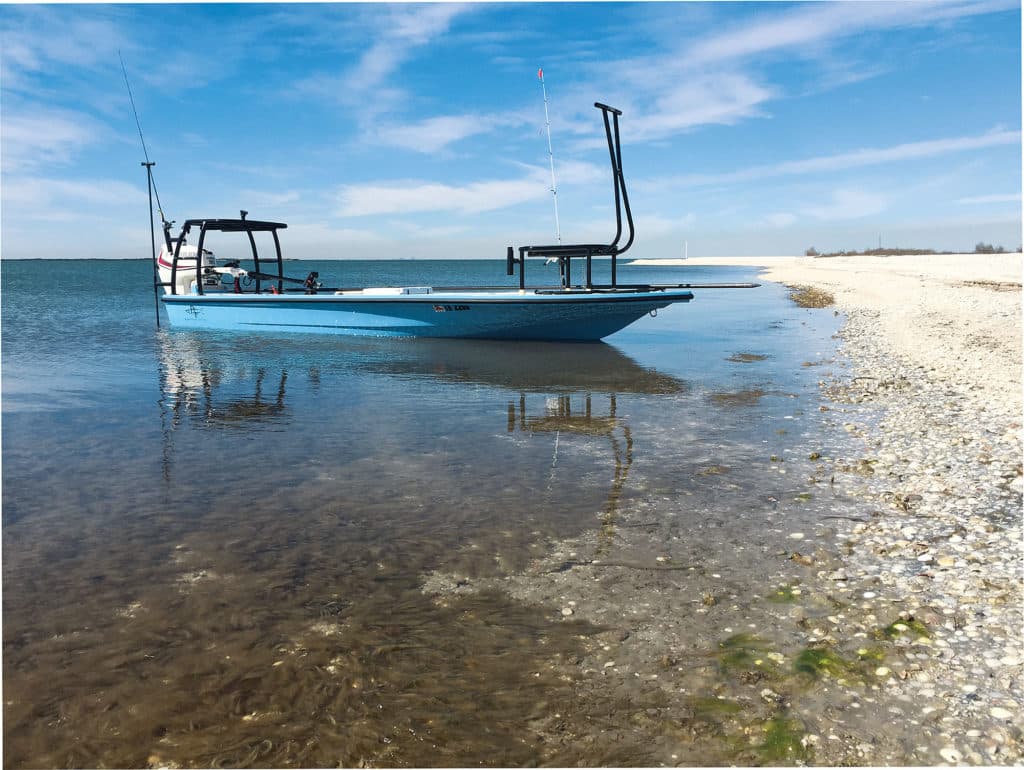
LOA: 16 ft. 8 in. • Beam: 5 ft. • Transom Deadrise: 3 deg. • Draft: 5 in. • Dry Weight: 400 lb. • Max Power: 30 hp Courtesy Beaver Tail
Beaver Tail‘s concept of a micro sets the beam bar at 64 inches or less, and stipulates only tiller or side-console setups, says Elizabeth Leslie, of Beaver Tail. “A microskiff should offer a true 5-inch draft fully loaded with two anglers, fuel and gear,” she adds. “It will take you to places that only kayaks could previously reach.”
The 16 BT Micro measures 5 feet — or exactly 60 inches — across its widest point, and it draws the requisite 5 inches. Its standard features include a large forward dry-storage compartment with easy access to the two six-gallon removable fuel tanks, a poling platform and trim tabs. It also comes with a four-rod rack and an aft compartment. But that’s about it. As with many microskiffs, the 16 BT Micro’s standard-gear list shows no livewell.
And while stability can be an issue with the narrow beam, “in the true microskiff world, being called ‘tippy’ is a compliment,” Leslie says.
The steep entry, flat bottom and curved transom combine to make the skiff track efficiently and hold its position in the wind. The design also negates hull slap.
“A microskiff is certainly not the right boat for everyone. It’s designed for purists who know exactly what they need from a skiff, and more importantly, exactly what they don’t need.”
Dragonfly Emerger 16
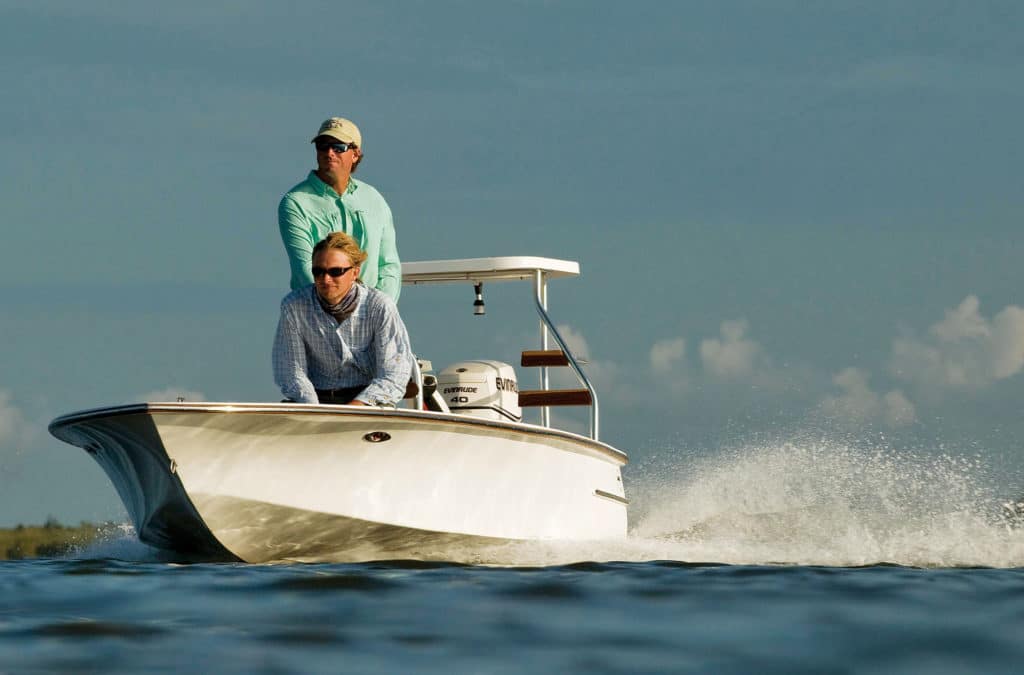
LOA: 16 ft. • Beam: 5 ft. 9 in. • Transom Deadrise: 11 deg. • Draft: 5 in. • Dry Weight: 500 lb. • Max Power: 70 hp Courtesy Dragonfly
Dragonfly‘s Emerger 16 sports a beam just under 70 inches, but it comes with 11 degrees of transom deadrise and a max power rating of 70 hp. So if it doesn’t exactly match up with true microskiff dimensions as defined by others, Dragonfly also offers the Marsh Hen 15, a 135-pound hull with a 50-inch — 4-foot-2-inch — beam. Some might say that’s a mini microskiff.
“We often feel that our 13-foot-6-inch Dragonfly paddleboard could be a microskiff, because it has all the attributes of a boat,” says Mark Castlow, Dragonfly’s founder. “A microskiff has minimal deadrise and rolled edges for nonreflective surfaces.”
Castlow says a few builders responded to a growing group of anglers — many very technical and others simply thrifty — looking for a small boat to fish two people in very shallow water. The stripped-down microskiff fits the bill and offers fishing purists the essence of simplicity.
The Emerger’s 69-inch beam, paired with just 16 feet of length, means this boat should tend toward more stability at rest than other micros. It also carries a little more fuel (18 gallons). However, that key draft figure remains just 5 inches.

